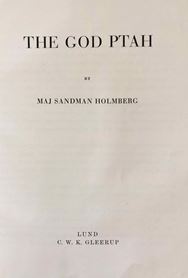
Ptah /ˈtɑː/ (Ancient Egyptian: ptḥ, reconstructed [piˈtaħ]; Ancient Greek: Φθά; Coptic: ⲡⲧⲁϩ) is an ancient Egyptian deity, a creator god[3] and patron of craftsmen and architects. In the triad of Memphis, he is the husband of Sekhmet and the father of Nefertem. He was also regarded as the father of the sage Imhotep.
Like many deities of ancient Egypt he takes many forms, through one of his particular aspects or through syncretism of ancient deities of the Memphite region. Sometimes represented as a dwarf, naked and deformed, his popularity would continue to grow during the Late Period. Frequently associated with the god Bes, his worship then moved beyond the borders of Egypt and was exported throughout the eastern Mediterranean. Through dissemination by the Phoenicians, we find figures of Ptah in Carthage.
Ptah is generally represented in the guise of a man with green skin, contained in a shroud sticking to the skin, wearing the divine beard, and holding a sceptre combining three powerful symbols of ancient Egyptian religion:
The Was sceptre
The sign of life, Ankh
The Djed pillar
These three combined symbols indicate the three creative powers of the god: power (was), life (ankh) and stability (djed).
From the Old Kingdom, he quickly absorbs the appearance of Sokar and Tatenen, ancient deities of the Memphite region. His form of Sokar is found contained in its white shroud wearing the Atef crown, an attribute of Osiris. In this capacity, he represents the patron deity of the necropolis of Saqqara and other famous sites where the royal pyramids were built. Gradually he formed with Osiris a new deity called Ptah-Sokar-Osiris. Statuettes representing the human form, the half-human, half-hawk form, or simply the pure falcon form of the new deity began to be systematically placed in tombs to accompany and protect the dead on their journey to the West.
His Tatenen form is represented by a young and vigorous man wearing a crown with two tall plumes that surround the solar disk. He thus embodies the underground fire that rumbles and raises the earth. As such, he was particularly revered by metalworkers and blacksmiths, but he was equally feared because it was he who caused earthquakes and tremors of the earth's crust. In this form also, Ptah is the master of ceremonies for Heb Sed, a ceremony traditionally attesting to the first thirty years of a pharaoh's reign.
The god Ptah could correspond with the sun deities Re or Aten during the Amarna period, where he embodied the divine essence with which the sun god was fed to come into existence, that is to say to be born, according to the Memphite mythological/theological texts. In the holy of holies of his temple in Memphis, as well as in his great sacred boat, he drove in procession to regularly visit the region during major holidays. Ptah was also symbolized by two birds with human heads adorned with solar disks, symbols of the souls of the god Re: the Ba. The two Ba are identified as the twin gods Shu and Tefnut and are associated with the djed pillar of Memphis.
Finally, Ptah is embodied in the sacred bull, Apis. Frequently referred to as a herald of Re, the sacred animal is the link with the god Re from the New Kingdom. He even received worship in Memphis, probably at the heart of the great temple of Ptah, and upon the death of the animal, was buried with all the honours due to a living deity in the Serapeum of Saqqara.
Scholars have also associated Ptah with the Mandaean angel Ptahil outside of Egypt due to their somewhat similar features and closely related names.

